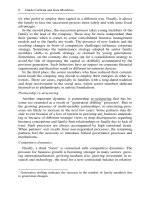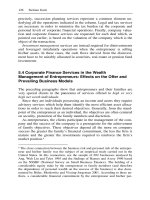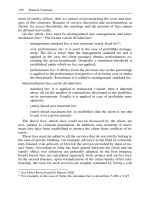Family Business Compensation
Bạn đang xem bản rút gọn của tài liệu. Xem và tải ngay bản đầy đủ của tài liệu tại đây (757.48 KB, 130 trang )
FAMILY
BUSINESS
COMPENSATION
Craig E. Aronoff
Stephen L. McClure
John L. Ward
Family Business
Compensation
Family Business Publications are the combined efforts of the Family Business
Consulting Group and Palgrave Macmillan. These books provide useful information on a broad range of topics that concern the family business enterprise,
including succession planning, communication, strategy and growth, family leadership, and more. The books are written by experts with combined
experiences of over a century in the field of family enterprise and who have
consulted with thousands of enterprising families the world over, giving the
reader practical, effective, and time-tested insights to everyone involved in a
family business.
The Family Business Consulting Group, Inc., founded in
1994, is the leading business consultancy exclusively devoted
to helping family enterprises prosper across generations.
FAMILY BUSINESS LEADERSHIP SERIES
This series of books comprises concise guides and thoughtful compendiums
to the most pressing issues that anyone involved in a family firm may face.
Each volume covers a different topic area and provides the answers to some of
the most common and challenging questions.
Titles include:
Developing Family Business Policies: Your Guide to the Future
Effective Leadership in the Family Business
Family Business Compensation
Family Business Governance: Maximizing Family and Business Potential
Family Business Ownership: How to Be an Effective Shareholder
Family Business Succession: The Final Test of Greatness
Family Business Values: How to Assure a Legacy of Continuity and Success
The Family Constitution: Agreements to Secure and Perpetuate Your Family and Your
Business
Family Education for Business-Owning Families: Strengthening Bonds by Learning
Together
Family Meetings: How to Build a Stronger Family and a Stronger Business
Financing Transitions: Managing Capital and Liquidity in the Family Business
From Siblings to Cousins: Prospering in the Third Generation and Beyond
How Families Work Together
How to Choose and Use Advisors: Getting the Best Professional Family Business Advice
Working for a Family Business: A Non-Family Employee’s Guide to Success
Letting Go: Preparing Yourself to Relinquish Control of the Family Business
Make Change Your Family Business Tradition
Making Sibling Teams Work: The Next Generation
More than Family: Non-Family Executives in the Family Business
Nurturing the Talent to Nurture the Legacy: Career Development in the Family Business
Preparing Successors for Leadership: Another Kind of Hero
Preparing Your Family Business for Strategic Change
All of the books were written by members of the Family Business Consulting
Group and are based on both our experiences with thousands of client families as well as our empirical research at leading research universities the world
over.
Family Business
Compensation
Craig E. Aronoff,
Stephen L. McClure,
and John L. Ward
FAMILY BUSINESS COMPENSATION
Copyright © Family Business Consulting Group, 1993, 2009, 2011.
All rights reserved.
First published by the Family Business Consulting Group Publications,
1993.
This edition first published in 2011 by
PALGRAVE MACMILLAN®
in the United States—a division of St. Martin’s Press LLC,
175 Fifth Avenue, New York, NY 10010.
Where this book is distributed in the UK, Europe and the rest of the world,
this is by Palgrave Macmillan, a division of Macmillan Publishers Limited,
registered in England, company number 785998, of Houndmills,
Basingstoke, Hampshire RG21 6XS.
Palgrave Macmillan is the global academic imprint of the above companies
and has companies and representatives throughout the world.
Palgrave® and Macmillan® are registered trademarks in the United States,
the United Kingdom, Europe and other countries.
ISBN 978-0-230-11103-5
ISBN 978-0-230-11600-9 (eBook)
DOI 10.1057/9780230116009
Library of Congress Cataloging-in-Publication Data
Aronoff, Craig E.
Family business compensation / by Craig E. Aronoff, Stephen L.
McClure, John L. Ward.
p. cm.—(Family business leadership series)
Originally published: New York, NY : Family Business Consulting
Group.
Includes index.
1. Family-owned business enterprises. 2. Compensation management.
I. McClure, Stephen L. II. Ward, John L., 1945– III. Title.
HD62.25.A756 2011
658.3'2—dc22
2010030932
A catalogue record of the book is available from the British Library.
Design by Newgen Imaging Systems (P) Ltd., Chennai, India.
First Palgrave Macmillan edition: January 2011
10 9 8 7 6 5 4 3 2 1
Transferred to Digital Printing 2015
Contents
E X H I B I T S A N D TA B L E S .
. . . . . . . . . . . . . vii
1 Introduction. . . . . . . . . . . . . . . . . . . 1
2 Compensation Philosophy . . . . . . . . . . . . . 9
3 Compensation 101 . . . . . . . . . . . . . . . . 19
4 Special Compensation Issues in Family Firms . . . . . . 49
5 Dealing with Challenges . . . . . . . . . . . . . . 77
6 Building Trust . . . . . . . . . . . . . . . . . . 91
7 Aligning Family Expectations and
Compensation Philosophy . . . . . . . . . . . . 105
8 Summary . . . . . . . . . . . . . . . . . . . 111
APPENDIX
. . . . . . . . . . . . . . . . . . . 115
R ECOMMENDED R EADING R ESOURCES
ADDITIONAL R ESOURCES
INDEX .
. . . . . 121
. . . . . . . . . . . 121
. . . . . . . . . . . . . . . . . . . . 123
T HE AU T HOR S
. . . . . . . . . . . . . . . . 127
Exhibits and Tables
Exhibit 1
The Flow of Funds in a Family Business: Role Confusion /
The Flow of Funds in a Family Business: A Rational System . 5
Exhibit 2
One Family Firm’s Compensation Philosophy . . . . . . . 13
Exhibit 3
The Compensation Philosophy of a Large Family
Business with Inactive Shareholders. . . . . . . . . . . 13
Exhibit 4
An “Equal-Wealth” Compensation Philosophy for
Sibling Partners in a Second-Generation Family Business . . 14
Exhibit 5
Internal and External Equity Ratios . . . . . . . . . . . 22
Exhibit 6
Example Job Description . . . . . . . . . . . . . . . 25
Exhibit 7
Excerpt from Point Factor Job Evaluation Tool . . . . . . 28
Exhibit 8
Point Factor Job Evaluation Results . . . . . . . . . . . 30
Exhibit 9
Wage Structure . . . . . . . . . . . . . . . . . . 32
viii
EXHIBITS AND TABLES
Exhibit 10
SEC Regulations on Disclosing Executive Pay . . . . . . 45
Exhibit 11
Examples of Family Benefits . . . . . . . . . . . . . . 89
Table 1
Ten Common Causes of Family Business Pay Problems . . . 7
Table 2
Steps in Building a Rational Compensation System. . . . . 24
Table 3
Some Criteria for Determining a Job’s Market Value . . . . 31
Table 4
Share of Compensation Typically Received in Incentives . . 39
Table 5
Some Bonus Incentive Examples . . . . . . . . . . . . 41
Table 6
Incentives for Key Non-family Executives . . . . . . . . 71
Table 7
Some Common Reasons for Hiring a Compensation
Consultant . . . . . . . . . . . . . . . . . . . . 73
Table 8
Common Compensation Trouble Spots . . . . . . . . . 78
Chapter 1
Introduction
Two Fusco brothers and a sister own and operate the printing business
started by their father 20 years ago in Cleveland, Ohio. Another sibling
is independently successful in real estate and inherited assets other than
company stock. Since their father passed away 10 years ago, they have
made many changes to the business. In fact, change has been continuous
as the business has grown and its customer and competitor markets have
evolved and new, more formal management practices have been introduced
in response. Among these changes has been the development of formal
marketing and human resources roles, first the introduction of an annual
budget followed by continual improvements each year in its use, adoption of a formal strategic planning process with short- and long-range
goals and defined accountabilities, and an ever-expanding customer and
prospect information system to measure and monitor service quality and
sales and marketing opportunities. The three employed siblings all agree,
except for long-term employees he would certainly remember, their father
would not recognize the business as the one he started.
The four second-generation siblings are in their late forties to midfifties and have ten children ranging in age from 14 to 26. The oldest of
the third generation, after successfully completing college and getting two
promotions in three years in a business in Oregon, has expressed an interest in joining the family firm. Her credentials are perfect for the business.
She can immediately make a very significant contribution to the quality
measurement process the business has been trying to implement. The question now confronting them is: if she joins, what should she be paid?
When the father started the business, he was alone and had no need
to think long term about the pay structure for the second generation. He
did not know it would be a family firm; he was just trying to make the
2
FAMILY BUSINESS COMPENSATION
business successful and, later, trying to take advantage of opportunities
for expansion. After a while the oldest of his four children joined the
business, and when the second-oldest expressed an interest, there was no
resistance; the business needed all the help it could get from hard-working and caring family members. When the second of their children was
about to join, the founder and his spouse talked it over and decided that
the pay should be the same for their two children working in what was
becoming a family business. The couple reasoned that it would be hard
to pay different amounts to their two oldest children, who were only two
years apart in age and had always used each other as a benchmark in
academic and sports pursuits, and certainly in the amount of attention
they received from their parents. There was no resistance from their children. At that time, the two siblings were more interested in contributing
to the exciting growth of the business.
By the time the founder retired, three of his four children were in
the business, all equally compensated. The fourth child never considered working in the business. Dad and Mom had completed their estate
plans and balanced the business’s value for the three active children by
bequeathing the family’s second home in a resort community along with
life insurance proceeds to their child who was not in the business. “Equal
assets to the four children” was the underlying theme as they responded
to their advisor’s many suggestions to minimize their taxes.
Ten years after their father retired, his oldest grandchild is expressing an interest in joining the business and the siblings are meeting to
consider the opportunity. Their conversation goes something like this:
◆
◆
◆
Youngest brother and parent of the candidate: I suggest we offer her 15 percent over what she is making now and provide moving expenses, just like we did when we hired the CFO.
Sister and aunt to the candidate: I can appreciate the
generosity of providing moving expenses, but as a quality analyst, on our organizational chart she will be on the same level as
our supervisors in the plant and we would never pay for moving
expenses to hire a supervisor.
Youngest brother and parent of the candidate: I can
understand what you are saying and it is wise to be consistent
with our policy. However, everyone understands that this is a
INTRODUCTION
◆
◆
◆
◆
◆
3
family company and family members, no matter how much we
try to behave otherwise, will always be treated differently.
Oldest brother and uncle to the candidate: She is just
right for the position, and it will be great to have her and her
new husband raise their family closer to us all. I am all for that,
but we need to consider the consequences for what we may do in
the next few years as others become old enough to join. Are we
deciding that we will always pay moving expenses and provide
a 15 percent increase in pay if our children want to come to work
here?
Youngest brother: You have a good point and we really need
to think this through. I’m starting to wonder how we reconcile
what we pay ourselves with how we treat our children. And, what
about our brother’s kids; he’s not an owner, but one of his two boys
may be very capable, may want to join, and we may very much
want to have him. Our system of equal pay has not been a problem
and I’d say it has allowed us to avoid a lot of problems. Maybe we
should pay each one in the third generation the same too.
Sister: While equal pay may not have been a problem for you,
I consider it unfair at a basic level. We each make vastly different
contributions to the success of this business, yet our pay is the
same year after year. I’m embarrassed to tell the kids that we do it
this way. Can we all agree that we will not repeat the equal pay
rationale in our children’s generation?
Oldest brother: You have never been this vocal about your
dissatisfaction with our pay system. I’ve thought it unfair too;
however, in thinking of solutions, I’ve always gotten stuck when
trying to figure out a way to change it.
Sister: Yes, and now we are getting stuck on how to pay our
niece. What will she think of us if she were to understand that we
are going to make her play by the standard employee pay rules,
yet we do not?
Compensation is at the heart of more family business questions than any other topic except succession. “What is fair pay
among family members? How do I determine the appropriate
pay for my son’s job? How should shareholders in the business be
4
FAMILY BUSINESS COMPENSATION
paid? How can I resolve family disputes over pay and still have
time to run the company?” All are common queries.
Pay is an immediate and tangible symbol of the family business’s multifaceted relationship with the family members and
others it employs. Unfortunately, cases like the Fuscos’ (a composite of examples from real family businesses) are all too common. It is extremely easy to confuse a paycheck in the family
business with return on ownership, parental concern, or methods
of achieving emotional goals. (Please see Exhibit 1.) The result
is a mixed message that can damage the business and the family.
With seemingly simple decisions about pay, the three Fuscos are
in jeopardy of undermining their credibility as professional business managers. If they choose to pay the younger family member
anything outside what they would pay a non-family employee
for the same job, they are saying, “Family members’ personal
needs override job contributions as a determinant of pay.” Yet,
like so many family firms before them, while the Fuscos have
made huge improvements to the business, they are still victims of
the antiquated pay system they started with and never changed.
No wonder compensation poses some of the most sensitive and
complex problems family businesses face.
The importance of family business compensation planning is
growing as more business owners bring multiple heirs into management. As discussed in Family Business Succession: The Final Test of
Greatness, our studies show that family business employment of
multiple offspring is about twice as prevalent as it was even 10 to
15 years ago. Questions over how to pay family members; how
to distinguish among their roles as employees, shareholders, and
loved ones; and how to maintain control over pay while keeping
everyone happy are driving many business owners to the brink
of burnout.
No family business is immune to such tensions and misunderstandings. In one case a younger brother in a middle management job in the family business was offended by the higher
salaries of an older sister and brother-in-law who had executive jobs. He surfed the Internet to conduct some misguided
research of his own in an effort to prove that he should make as
EXHIBIT
1
6
FAMILY BUSINESS COMPENSATION
much as they. The resulting discord blocked important planning
for months.
In another case, a second-generation shareholder not active
in the fast-growing family business complained about his siblings’ big salaries, company cars, and country club memberships.
He disregarded the fact that in addition to paying him and other
shareholders ample dividends, his siblings had tripled the size of
the company, multiplied the value of his holdings, and used the
perks mostly on company business.
In another common problem, the details of employee compensation issues can mount to overwhelming levels in a growing business, engulfing the entrepreneur in minutiae. As business
owners spend more and more time on individual compensation
questions, most at some point throw up their hands and say, “This
pay and benefits business is crazy! We’ve got to have a system
that makes all this make sense. We need some rational basis for
these decisions—not all this stuff about people’s emotions and
personal needs!”
Whether frustration or proactive management produces
systematic compensation policies, the result encourages professional growth among family members and other employees, as
well as strategic business goal accomplishment. A rational system
involves communicating a clear understanding of the value of
various company jobs. It means weighing family members’ expectations about lifestyle and, often, encouraging them to accept
financial responsibility for themselves. It also means grasping a
powerful tool to educate employees about the business, foster
their trust, and motivate them to perform well.
To accomplish this, many family businesses find they must
discard some extremely common and popular notions about
using pay for other purposes—ideas that can seriously hamper
sound planning. Some of these notions, including several affecting the Fuscos, are summarized in Table 1 and are examined in
greater depth in Chapter 5.
Chapter 2, will explore some principles in developing a philosophy of compensation and provides examples of different philosophies to match variations in types and stages of family firms.
Table 1
Ten Common Causes of Family Business Pay Problems
Role Confusion: Confusing payouts to family members in their roles
as owners or loved ones with compensation for performing a job in
the business.
Using Pay to Achieve Tax Savings: Using high salaries, perks, or
“phantom jobs” to transfer tax-deductible wealth to family members
and avoid the heavy taxes imposed on dividends or gifts.
Using Pay to Maintain Parental Control: Using paychecks to convey
messages or accomplish goals that have nothing to do with
the market value of the job performed, such as luring reluctant
children to work in the business or pressuring offspring to learn the
importance of frugality.
Using Pay to Resolve Emotional Issues: Providing extra pay to ease
uncomfortable feelings, such as parental guilt or resentment among
offspring.
Preserving Secrecy at All Costs: Assuming that it is always indiscreet,
impolite, or just plain wrong to talk about how people working in the
business are paid.
Confusing Business and Personal Funds: Assuming you can draw as
much compensation from the business for as long as you need it to
support the retirement lifestyle of your choice.
Taking Relationships for Granted: Assuming family members will trust,
respect, and be satisfied with your pay decisions just because they
are family members.
Using Salary Substitutes: Offering titles, perks, or other “salary
substitutes” to appease family members unhappy with their pay.
Paying Everyone Too Little—or Too Much: Holding down topmanagement pay as a way of suppressing compensation
throughout the organization; or, conversely, raising pay too high to
retain people and avoid having to tell longtime employees how they
are doing.
Using Pay to Smooth Ups and Downs: Altering pay to soften the
impact on employees of ups and downs in the business, paying
more in lean times to prove that you are a great boss and paying
less in good times because there is no need to prove anything then.
8
FAMILY BUSINESS COMPENSATION
Chapter 3 provides a quick course in how businesses establish
rational market and merit pay systems. Chapter 4 offers practical
guidance on special issues such as the role of compensation in
providing support for retiring business owners, compensation for
non-family executives, recruiting employed family members, and
the use of a board compensation committee and a compensation
consultant. Chapter 5 provides forewarning information to help
avoid pitfalls and offers transitioning steps for moving from pay
systems that are not sustainable to rational market and merit pay
practices.
Chapter 6 describes ways to build trust in the compensation
system among family members, employees, and other constituencies. Finally, Chapter 7 offers ideas to help shape the expectations of family members and others around the ideals and goals
that underlie sound pay practices.
Chapter 2
Compensation Philosophy
or many business owners, recognition of the need for change in
compensation practices begins a process of transformation.
As they try to develop some kind of system, most family
businesses create a philosophy of compensation and a way of
communicating it to employees. In the process, compensation
becomes a tool for carving out new milestones.
That’s not to say that the business owner must embrace a
rigid, bureaucratic method that eliminates human judgment or
an owner’s prerogative. We know of no foolproof compensation system that has employees consulting a graph or pushing
a button on a computer to find out what they will be paid next
year. Rather, business owners at this stage, often with the help of
directors or professional advisors, focus on systematically aligning compensation with their goals and mission for the business.
This section outlines the first step in building a rational compensation plan: developing a philosophy of compensation that
builds a framework for base pay and incentives tailored to the
special values, goals, and needs of the particular family firm.
F
DEVELOPING A PHILOSOPHY
OF COMPENSATION
A good compensation plan should provide incentives so that
everybody involved in the business works for what is best for
10
FAMILY BUSINESS COMPENSATION
all. To accomplish that, the plan must reflect the business’s core
philosophy.
A philosophy of compensation is a summation of the values,
goals, and principles that guide all decisions about salary, benefits, and perks. It provides a framework that relieves decision
makers of the burden of developing each compensation package
individually. Building and describing this framework can force
business owners to assess their most fundamental goals.
A central question is how the company remains competitive. Some companies, for instance, stress increasing shareholder
value. This emphasis on profit maximization underlies a belief in
hiring and retaining people at relatively low pay, charging customers higher prices, and keeping supplier costs low, resulting in
the best possible returns to shareholders.
Others take an employee-driven approach that focuses on
creating the best possible opportunities and environment for
employees. This reasoning holds that if employees are encouraged through attractive pay, benefits, and perks to perform at
their highest potential, stockholders, customers, and other constituents will benefit from improved productivity, efficiency, and
quality.
Other businesses put service to the customer first on the list.
This reasoning holds that if customers are attracted and retained
through low-priced, high-quality products, the business will
grow, creating new jobs for employees and higher returns for
shareholders.
Most business owners would agree to some extent with all of
these priorities. The question is usually one of emphasis—which
of these goals do strategists stress most often, and which are the
most central to their mission? The answer can strongly influence
how compensation philosophy is determined and articulated.
Another philosophical issue that impacts compensation is the
owners’ attitude toward risk. Those who believe that the risk and
the rewards accrue to the owners tend to focus compensation
on a relatively fixed salary. Those who believe that employees
should participate in business risk may make salaries lower and
variable bonuses a larger part of total pay.
COMPENSATION PHILOSOPHY
11
Another central issue is determining how jobs are valued.
The backbone of compensation policy might be, for instance,
that everyone is paid according to the market value of the job
performed. Other family businesses may add “qualitative” criteria, such as the leadership, communication, or analytical abilities
required to do a particular job well in a particular company. (See
“Job Evaluation” section in Chapter 3.) Still others may decide to
pay family members equally, reflecting an attitude of “one for all
and all for one.”
Whatever the choices made on these issues, the fundamental
requirement is that the compensation philosophy provide for a
consistent, aboveboard approach to pay.
SHOULD WE EMBRACE A MARKET APPROACH?
To avoid problems, there is no substitute for paying people based
on the size and difficulty of the job and in relation to comparable
jobs at comparable companies. In other words, the marketplace
provides the basis for compensation policy and owners should
make sure that everyone understands how pay is determined.
Market value is a fair and consistent guide to setting pay,
and it is relatively easy to explain to employees and shareholders. Simply put, a market value philosophy means you pay an
employee what it would cost you to hire someone else to do the
job. Its objective basis reduces the potential for misunderstanding
and manipulation. It gives family members and other employees
a realistic view of the value of their work, and it drains negative
emotion from sensitive family interactions over pay.
Yet “pay people what their job is worth” is easier to say than do.
Some family businesses decide for good reason not to embrace
a market value approach, and any business considering doing so
for the first time should stop to consider the ramifications.
In some businesses, pay has been set on non-market criteria for
a long time. Some family members and other loyal employees may
have been increasingly overpaid over the years. Family members
12
FAMILY BUSINESS COMPENSATION
who have been relatively underpaid may not see any reason to
stir up the issue and hurt people’s feelings. The status quo may be
acceptable, and introducing market data or consultants’ appraisals
that expose inequities may only open unnecessary wounds.
Before taking even preliminary steps to seek data or make
comparisons with other businesses, the following questions
should be considered:
1. How has pay for family members been set in the past?
2. Are there important reasons to change to a “market value”
approach?
3. If we do get objective data and it shows significant inequities, what will we do then?
These issues are especially important when the business is
passing to a new generation of family members. During preparation for succession, members of the younger generation should
meet to discuss the above questions and decide whether a change
is needed.
The market value approach does have some advantages at this
stage, at least until next-generation successors become substantial shareholders. If inequities in pay exist, they inevitably will
come to light at some point as the next generation assumes leadership and ownership. If potential problems are not addressed
early, they may become more painful and difficult to resolve
later. In most cases, by the time that the successor generation is
established in its careers, family businesses decide pay should be
based on the market value of jobs.
But before determining the market value for jobs held by family members, consider and discuss what steps you want to take if
market value and actual pay are very different—either higher or
lower. A little preparation will make family members less likely
to respond defensively or mount an attack once comparable pay
data is received. They also will have an opportunity to provide
hands-on job descriptions to assist data gatherers and may learn
something about their own jobs in the process.
Some examples of family business compensation philosophies
based on the market value of jobs follow in Exhibits 2, 3, and 4.
COMPENSATION PHILOSOPHY
13
2 One Family Firm’s Compensation
Philosophy
EXHIBIT
◆
◆
◆
◆
◆
◆
We will compare pay and performance levels with those
of businesses with whom we compete for employees.
Our goal is to provide total compensation between the
median and 75th percentile of comparable groups.
Base salary will be at or below the median level for the
comparable groups. Individual salaries will be held within
20 percent of the midpoint for our comparison groups’
salary range.
We will emphasize performance-based incentives at the
expense of base salary.
Annual incentives will exceed those of comparably sized
competitors.
Long-term incentives will be based on results that add
shareholder value.
The following is an example of the pay potential for a particular job under this compensation philosophy. Base salary is
set at the median level for comparable groups of $136,000. The
maximum base salary is $163,000 (median plus 20 percent) or a
minimum of $109,000 (median minus 20 percent). The target for
the short-term incentive in this job is 25 percent of compensation, or $34,000. The maximum short-term incentive is $68,000,
3 The Compensation Philosophy of a Large
Family Business with Inactive Shareholders
EXHIBIT
Here are some principles from the compensation philosophy of
a large, second-generation family business with several family
members who own stock but do not work in the company:
◆
Compensation should be objectively determined relative to
the real market value of comparable jobs.
14
FAMILY BUSINESS COMPENSATION
◆
◆
◆
◆
◆
Pay should be somewhat conservative given family ownership
and the uncertainty of the economy.
Compensation should be at the median or midpoint of
rewards for target performance at comparable companies,
even though our targets (in some years, 15 percent ROE
and 15 percent sales growth) are far higher than average.
Our salaries and short- and long-term bonus packages should
compare with professionally managed, public companies.
Pay is based on the “size of the job” (i.e., its complexity)—
not the title.
For family executives, we tie long-term bonuses to shareholder value increases, as measured by a three-year average of our performance on growth and return on equity.
Executives may take their long-term incentive in stock or
cash, but they are encouraged by a 10 percent discount
on stock prices to use this bonus to buy stock.
or 50 percent of target. The target long-term incentive also is
25 percent of compensation, or $34,000. The maximum longterm incentive is $51,000, or 150 percent of target.
4 An “Equal-Wealth” Compensation
Philosophy for Sibling Partners in a Second-Generation
Family Business
EXHIBIT
◆
◆
◆
◆
◆
Our long-range goal is “equal wealth” rather than “equal
income,” because all share equally in equity.
Over time, our hope is that each will contribute substantially to the wealth of all.
We will share new investment opportunities with each
other, giving each a chance to participate.
We want to ensure each an adequate income from family
resources to meet accustomed lifestyles. To that end, we
will guarantee a minimum family income of $130,000.
To reflect the high value and shared responsibility we
assign to the executive committee function, an additional
COMPENSATION PHILOSOPHY
◆
◆
15
$40,000 will be paid each family member for serving on
the executive committee.
In addition to minimum family income, we want to offer each
sibling pay reflecting the value of their job in the business.
When desirable, we will offer some family members additional bonus opportunities on the job, if we believe it will
increase the value of our shared business investment.
HOW THE CULTURE OF THE BUSINESS
MAY AFFECT YOUR PHILOSOPHY
Some business owners find compensation issues surprisingly difficult to deal with.
One reason is that any business’s compensation policy is
deeply rooted in its culture—the implicit beliefs, values, assumptions, habits, and behavior patterns that color the fabric of the
organization. The reasons people are paid the way they are may
be partly unconscious and may arise from the personal and family history and the deeply felt personal needs of the business
leader or leaders. Any family business that tries to develop a philosophy of compensation may learn a great deal about itself in
the process.
Let’s take a look at how some kinds of family business cultures can affect compensation.
The Entrepreneurial Culture. Many first-generation family
businesses use compensation as a way to achieve tax savings
and maximize the entrepreneur’s control over the business. The
entrepreneur has confidence in his or her ability to manage compensation on a case-by-case basis and maintains tight personal
control over each individual’s pay, perks, incentives, dividends,
and gifts. If a family member working in this kind of culture asks
for a raise, the business owner may brush her off with, “Look
at what we just did for you at Christmas! Let’s not talk about
compensation.” Similarly, if a shareholder asks about returns on
16
FAMILY BUSINESS COMPENSATION
capital, the business owner may respond, “Remember what we
did for you when you worked in the business? Let’s not start talking about dividends.” Secrecy and ambiguity about compensation keep power in the hands of the entrepreneur and prevent
any open complaints about fairness.
The Paternalistic or “Family-First” Culture. Decisions in this
setting are guided by the business leader’s judgment on how best
to meet family needs. This leader might allot raises to children
in financial trouble or offer hefty incentives to lure a young family member into the business, regardless of that person’s merit
or the job to be performed. The overriding concern in this setting is keeping the family together and working in harmony. The
professional needs of individuals may be satisfied as long as they
do not compromise the “family welfare,” as interpreted by the
business leader. Maintaining secrecy about compensation is a
likely component of this culture, because it increases the business leader’s control over family relationships.
The Bureaucratic Culture. In this culture, the business owner
creates such a rigid and complex process for setting compensation that any goals that might be achieved through managing
pay are forgotten. Employees might all get the same percentage
increases each year as part of a formalistic procedure, but no
one’s heart—or judgment—would be in the process. In such a
system, compensation becomes an end and not a means. What
people are paid has nothing to do with the direction or goals of
the organization.
In some ways, a bureaucratic system is the opposite of an
entrepreneurial culture. It sometimes even results from businessowner burnout caused by the pressures of the entrepreneurial
culture. Some business owners become so pained by complex,
subjective pay decisions that they create a bureaucratic system
that completely removes decision making from their shoulders.
If a person complains about pay, the business owner then can
shrug and say, “Look, I’m sorry, but you’ve been here 14 years
in this job and that’s what the pay level is.” While this avoids the
stress of the more personal entrepreneurial approach, it wastes









